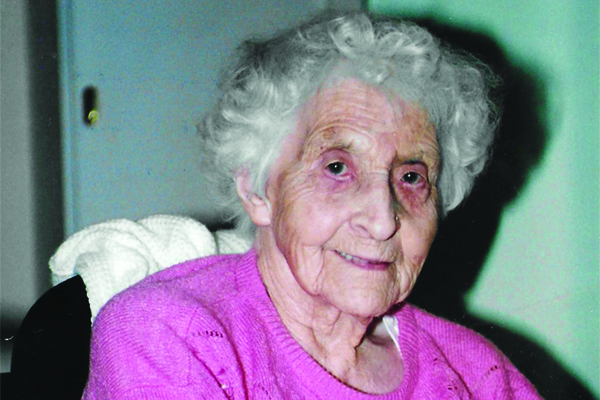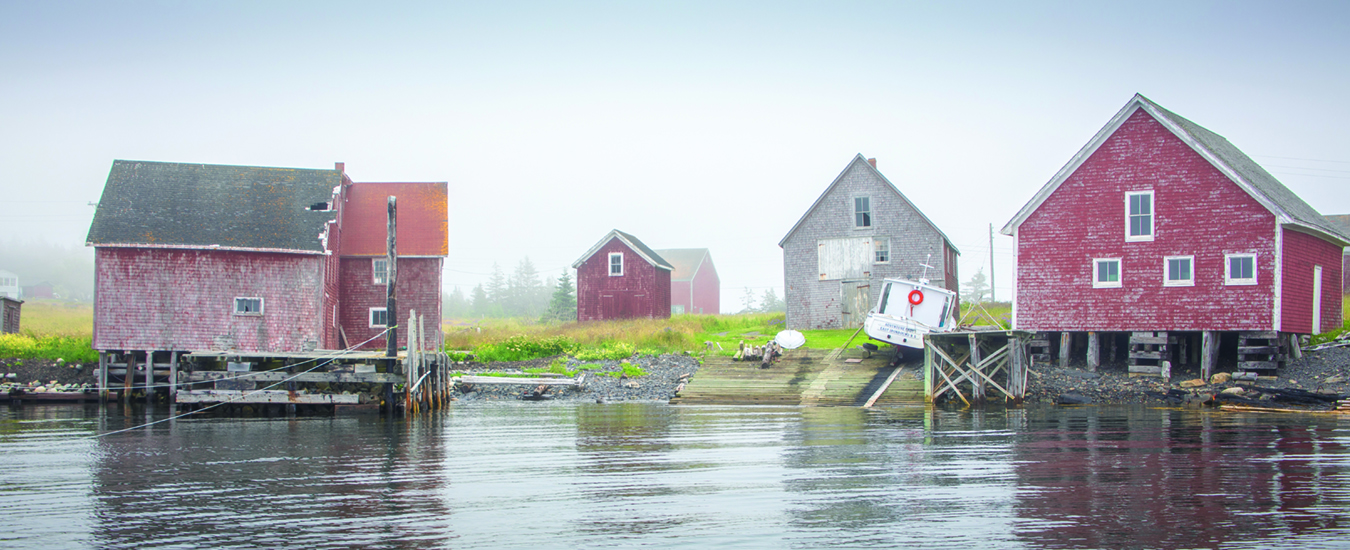A very different and difficult life on an island—not that long ago
by Bonita Matthews
East Ironbound, the tiny island located off of Lunenburg County’s Aspotogan Peninsula, marks the entrance to Mahone Bay and hosts one of the last surviving lighthouses in Nova Scotia. Built in 1871 it still stands tall at 46 feet on the highest point of the island. Scattered here and there, along with the one permanent residence, you see the original family homes—now summer escapes. Rugged rocks, beaches and meadows on this island have provided the perfect canvas for artists. The colourful family history has been captured by author Frank Parker Day in his book Rockbound. Film crew for the 2000 movie Deeply also made their home here for a short while. I visit to embrace the solitude, comb the beach, climb the rocks, and fantasize about what life would have been like here.
Who better to tell me than Shirley Dawson, whose father was Edward Finck, the lighthouse keeper for Ironbound from 1930 to 1955. Shirley was born in that lighthouse in 1931. Her father had also been born and raised there and knew no other life but that of Ironbound. When not at the lighthouse, he worked with his team of oxen to haul his boat up the skidway to the boathouse, move rocks and timber, and garden. To simply survive you had to be strong and self-sufficient. Yet as a toddler, Shirley didn’t remember her father in that way. Her earliest recollections of him were that of a man who was physically handicapped, who walked with cane and was eventually confined to his bed. He had been diagnosed with a growth on his spine which, after surgery, changed his life, and that of his family, forever. Shirley’s fondest memory of him was watching him as he sat mending nets alongside his buddy, a little duckling that stayed near him quite often.

Photo credit: Courtesy of Richard Dawson
Shirley’s mother, Violet Mae, was from Big Tancook Island. She and Edward married in Mahone Bay in 1913. Little did the young bride know she would become a mother of six children, and keeper of the light.
“Life was hard,” said Shirley. “There were farm chores such as haying, weeding of the huge cabbage patches, which the women were responsible for as the men were fishing. I was the baby of the family, and helped out where I could, but my main job was collecting the eggs from the hen house. And then, of course, there was the light that had to be cleaned constantly and polished inside and out, and the kerosene lamp filled every night. My mother did all of that. When she wasn’t up and down those stairs every day, caring for my father, or working outside, she was scrubbing floors, cooking, and doing laundry. She lived to be 108 years old. I guess hard work doesn’t hurt you.”
There was always that constant worry when the government inspectors made their yearly visit to find their keeper eventually bedridden and a woman assisted by six children operating the lighthouse. Along with all of the work of her daily life, Violet Mae carried the weight of concern that they would be evicted and end up in the poor house. To this date all records show Edward Finck as the keeper of East Ironbound light from 1930 to 1955.
The lighthouse dwelling was tiny. There were only two bedrooms upstairs for the children to share. Shirley always dreamed of the day when she would have her own room and not have to share with her sisters and the odd June bug which would drift down from the light and torment them at night. The children were responsible to make sure the light was still lit every night before they fell asleep. Her parents had no bedroom of their own and slept downstairs in the living room, as there was only the kitchen and the living room available to them on the main floor. The wood stove was the main source of heat and hot water for laundry, dishes, and Saturday night bath night. Shirley chuckled, “the good ol’ days … not an easy life.”
Shirley remembered it as pretty much all work on the island. The shared livestock arrived by boat. She smiled as she recalled the story of the oxen delivery. Her mother had related how the men “took a couple of big poles, put them under the oxen bellies one at a time and pried them up and over the side of the boat. They went down with their big eyes bugging out and four feet sticking straight up in the air. Right away they came to the surface, just a-snortin’ and a-blowin’ and then swam away to the island shore. It was kind of funny to see.”
Children were schooled in the one-room school house, and the teacher would board with one of the families and quite often became a bride of one of the hopeful fishermen. One teacher taught Shirley how to knit as a pastime, and warm socks were in high demand on the island. Although she also loved to read, the only book she possessed was Little Women, unless the Sears or Eaton’s catalogues made their way over, and they would be treasured as well. A church service was held at one of the houses every second Sunday when the Baptist minister would arrive by boat, weather permitting. The large pump organ that was used in that church eventually made its way to the mainland and is now found at the home of Shirley’s son. The church house was believed to be haunted, with “things going on” such as the clock always striking thirteen.
There was no medical clinic, and babies were delivered at home. For medical and dental care, it was necessary to sail to the mainland. A doctor’s house call would mean a three to four-hour sail from Chester, so it was just easier to look after things yourself.
Although they farmed and fished together, there was no socializing between the two families that lived on the island. The Youngs and Fincks kept to themselves, protective of “their land” and there was no mixing or crossing of boundaries. Initially the Youngs had owned the island but the marriage of one of their daughters to an outsider changed everything. The Fincks becoming landowners resulted in years of ongoing pettiness and animosity. There were only two little girls about the same age as Shirley on the island, and they were never allowed to play together. When Shirley would come by, their mother would drag her daughters in from outside and close the door.
At home, there was work and more work to do from dawn to dusk. The happiest times Shirley can recall were those she spent with her cousin Russell, her best friend, whose mom always had a good supply of gingerbread cookies, and hugs. She was a “four-foot, seven-inch firecracker of a lady” who Shirley visited every day. She looked to her as her second mom whose warmth and kindness helped her survive, and she was forever grateful for that.
The only wildlife on the island were the pheasants that someone brought over for hunting, and snakes—those awful snakes. Shirley remembered the time she accidentally stepped on a snake’s tail, only to have it slither up her leg. “Well, that was some cold.”
One time someone brought over two kittens, and Shirley fell in love with the female, her one and only pet. Unfortunately, the other kitten was male and eventually baby kittens were in supply, yet kept disappearing, until one day Shirley’s cat went missing too, and she never saw it again. “There really was no place for pets … not enough food to properly care for them … barely enough to feed our own family by times,” according to her mom. Shirley could tell by her mom’s grim expression that her pet was gone for good, and there would be no more. “I never forgave her for getting rid of them all,” Shirley said, “but when I look back, I think of how hard she toiled day and night and the pressure she was under looking after everything … and I guess I understood.”
Summers (when chores were over) would find her, the youngest of her brothers, and Russell at the beach: “not swimming—that water was way too cold!” But beach combing, picking cranberries, and sometimes “swiping a few strawberries and kindling” when the neighbour wasn’t looking, on their way home.
Winters were terrible, and with it came total isolation due to pack ice, which meant no movement to or from the island. But this was the best time to fill your day with fun things to do, and Shirley’s brothers and sisters took advantage of that with skating, tobogganing and bobsledding from the top of their hill down as far as they could go. As long as they didn’t run out of island, they were okay. It was so cold though that when the laundry came in off the line it was frozen stiff and stood up by itself for a time.
Windstorms were incredible and something Shirley would never forget. There was no rock barrier or wharf when she lived on Ironbound and it would be something to see—the fury of the Atlantic as the waves rose from opposite sides, met, and then washed away. While Shirley was there, she recalls only one ship capsizing during one of those fierce storms, and the islanders, strange as it was, working together to bring those fishermen to safety.
The family didn’t leave the island for the mainland very often. Sunday afternoons would sometimes find them boating over to Tancook Island to visit Shirley’s grandmother, and Shirley looked forward to those trips. Leaving Ironbound was a treat, if only for a day, and she looked forward to the time when she would leave it for good.
One by one, her brothers and sisters moved away, until only Shirley and her oldest brother Charles remained. He chose to continue on as a fisherman and then lighthouse keeper. At 18 years of age, Shirley left for good to join her sister in Halifax and see what life would have to offer her there.
Although their term at the lighthouse was finished in 1955, Shirley’s parents remained on Ironbound for 10 more years or so, and then relocated to the Head of St. Margaret’s Bay. Edward died on June 18th 1970 at the age of 82. Violet Mae spent her final years at Melville Heights and passed away two weeks short of her 109th birthday.
Intro Credit: Shaun George
Intro caption: The lighthouse and dwelling for the East Ironbound light station, ably tended by Shirley Dawson’s family for many years.
Header credit: Joseph shrock
Header caption: The fishing village today.
